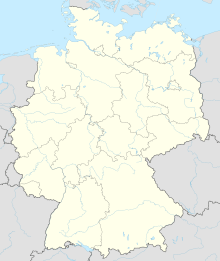Langenbruck bus crash facts for kids
Quick facts for kids Langenbruck bus crash |
|
|---|---|
| Details | |
| Date | 11 February 1985 3:09 pm (local time) |
| Location | Langenbruck |
| Coordinates | 48°38′20″N 11°31′12″E / 48.639°N 11.520°E |
| Country | West Germany |
| Cause | Collision |
| Statistics | |
| Bus | 1 |
| Vehicles | 2 |
| Passengers | 39 |
| Crew | 2 |
| Deaths | 21 |
| Injured | 18 |
The Langenbruck bus crash happened on February 11, 1985. A double-decker bus was carrying about 40 musicians. They were part of the band of Royal Air Force Germany (RAFG). The bus crashed on a major highway, called an autobahn. This happened between the cities of Nuremberg and Munich.
The serious accident took place near the village of Langenbruck. This area is about 18 miles north of Munich. At that time, it was in West Germany, which is now part of Germany. Sadly, 21 people on the bus died in the crash. This included the bus driver and one RAF policeman. The other 19 people who died were RAF bandsmen. Six of these military victims were buried in a cemetery in Germany. This cemetery is located at RAF Wegberg (also known as Rheindahlen Military Cemetery). The other victims were sent back to the United Kingdom. This crash was considered the worst bus accident in West Germany in 20 years, based on the number of lives lost.
What Happened: The Bus Accident
On February 11, 1985, a bus carrying members of the Royal Air Force Germany band crashed. The accident occurred on the autobahn south of Ingolstadt. This road connects Nuremberg and Munich. Reports said the bus caught fire after it crashed. It hit the back of a truck carrying a large amount of aviation fuel.
The band was based at RAF Rheindahlen at the time. They were traveling to an event in Bad Kohlgrub, Bavaria. This event was at the Royal Air Force Germany Winter Survival School. The crash resulted in the deaths of 19 musicians, the bus driver, and one Royal Air Force Policeman. Official records show that 43 people were on the double-decker bus. The band usually had 42 members, plus the driver and one RAF policeman. However, one bandsman was sick and did not travel.
Initially, 24 people survived the crash. Some survivors found it hard to escape. An emergency door on the lower deck was stuck shut. The bus crashed into the fuel truck at 3:09 pm local time. This happened at Langenbruck, about 18 miles north of Munich. It was also about 12 miles south of Ingolstadt. The fuel truck began to leak its fuel. The road was said to be icy. When the truck driver realized fuel was leaking, he slowed down. The bus then slipped on the leaking fuel. The fuel truck driver managed to move his vehicle about 500 yards away. This helped prevent the rest of the fuel from catching fire.
Witnesses described seeing people who were badly burned. They also had to help people who were in shock. The bodies of those who died were removed on February 13. They were then returned to RAF Rheindahlen. Eighteen people died right away in the crash. Three more died later in the hospital. Some victims had severe burns. Because of this, they had to be identified by their dental records. After a short ceremony, some of the deceased were flown to RAF Lyneham in Wiltshire. This happened on February 19. Other families chose to bury their relatives in the cemetery at RAF Wegberg. This incident was the worst bus crash in West Germany in 20 years. In 1966, 33 people died in a bus crash between Frankfurt and Cologne.
After the Accident: What Changed
By April 1986, the band of Royal Air Force Germany was back to its full size. They continued to perform musical events.
The motor industry and some members of the European Parliament discussed the accident. They suggested that flammable liquids should not be transported when roads are icy. Dutch police were given permission to stop foreign drivers. This was if they were carrying flammable loads and road conditions were bad. The safety of the bus itself was also discussed in Germany. Many Neoplan double-decker coaches, like the one in the crash, were used there. The bus doors were sealed using a hydraulic system. This made them difficult to open. Also, the top deck of the bus did not have any emergency exits.


